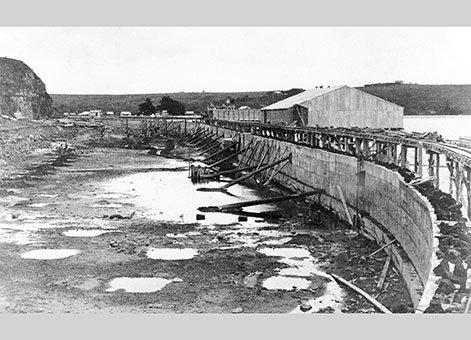Kelly Tarlton’s Underwater World, opened in January 1985, is a fine example of entrepreneurial engineering. Innovatively created inside disused sewage holding tanks beneath Tamaki Drive, it is one of Auckland’s major tourist attractions.
The underground tidal storage tanks were built as part of the early 20th century Orakei sewerage scheme. The storage tanks were fed by the Hobson Bay sewer pipe. Wastewater was held here and released via the Orakei sewer outfall on high tide. The tanks had a capacity of 37,000 m³ and were constructed with reinforced roofs in anticipation of an electric tram system going over top. Sewerage was screened prior to discharge to remove large debris. The substantial screening building was a large brick structure complete with furnace and chimney.
The storage tanks were decommissioned in the early 1960s. Nearly 20 years later, in 1983, Kelly Tarlton proposed that the disused, well-built tanks be converted into an aquarium.
Kelly Tarlton died in 1985, aged 47, not long after welcoming the 100,000 visitor to his namesake aquarium. He was a world renowned diver with an impressive list of achievements in the underwater sphere.
The aquarium is designed to recreate the world divers experience on a typical Hauraki Gulf volcanic reef. Spectators move through this world inside a clear acrylic-covered tube set in a trench in the base of the aquarium. They travel on a conveyor belt, stepping on and off to watch colourful fish life around and above them.

Construction of the Orakei sewerage scheme storage tanks (1911), now part of Kelly Tarltons Underwater World. Photograph courtesy of Watercare Services Ltd.
Until the opening of Kelly Tarlton’s in 1985, conventional aquaria used acrylic panels in flat sheets in viewing galleries. The construction techniques developed to construct the acrylic tunnels were unique and have since been successfully used internationally.
The project showed that New Zealand engineers are not afraid to try something new. After research into new materials and methods such as acrylics and silicones, waterproofing and fish care, Kelly Tarlton's team evolved techniques to overcome the problems encountered. They developed ways of bending acrylic sheets into arches, forming horizontal bends using “lobster-back”, and adapted a baggage conveyor for the transport system. The mechanical services and water-filtering equipment were all designed and built to meet the particular requirements of the project.
The subsequent companies formed by Kelly Tarlton’s associate, consulting engineer Ian Mellsop, have played major roles as specialist consulting in five “underwater world” complexes in Australia and Asia. In 1990 they had four more aquaria in the initial planning stages in Australia, Hong Kong, Hawaii and Europe.
Architectural – Structural – Mechanical Design: Bruce Wallace Properties Limited.
Construction: Kelly Tarlton and Precast Construction Limited.
Heritage recognition
IPENZ “Engineering to 1990” project
This item of New Zealand’s engineering heritage was recognised as part of the IPENZ “Engineering to 1990” project, which the Institution organised to help celebrate the country’s sesquicentenary in 1990. A plaque was unveiled to mark the significance of this underwater world as part of the development of the nation.
More information
Read a biography of Kelly Tarlton
Access
The Kelly Tarlton's Underwater World website has opening hours and ticket price information.
Reference
Karen Wrigglesworth, 'World-first Fish World,' Engineering Insight, Vol. 13:2 (2012), pp.24-26.
Location
23 Tamaki Drive, Orakei, Auckland.
